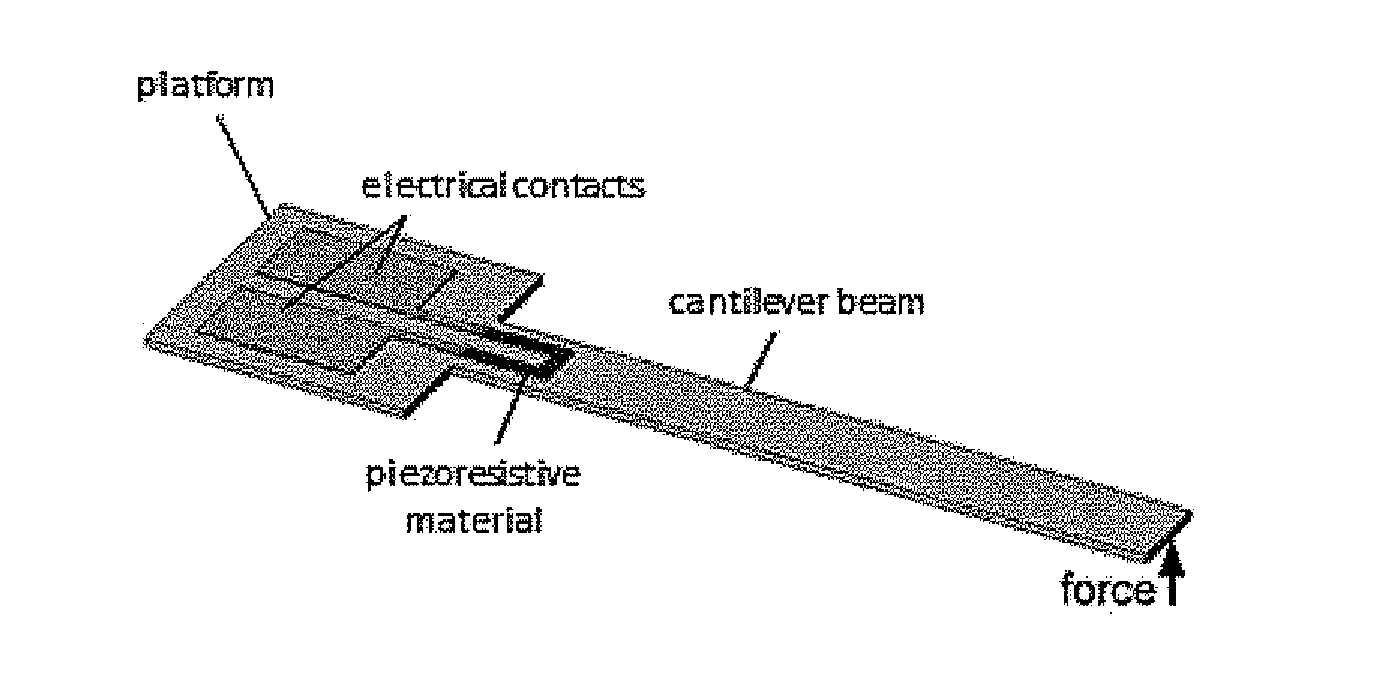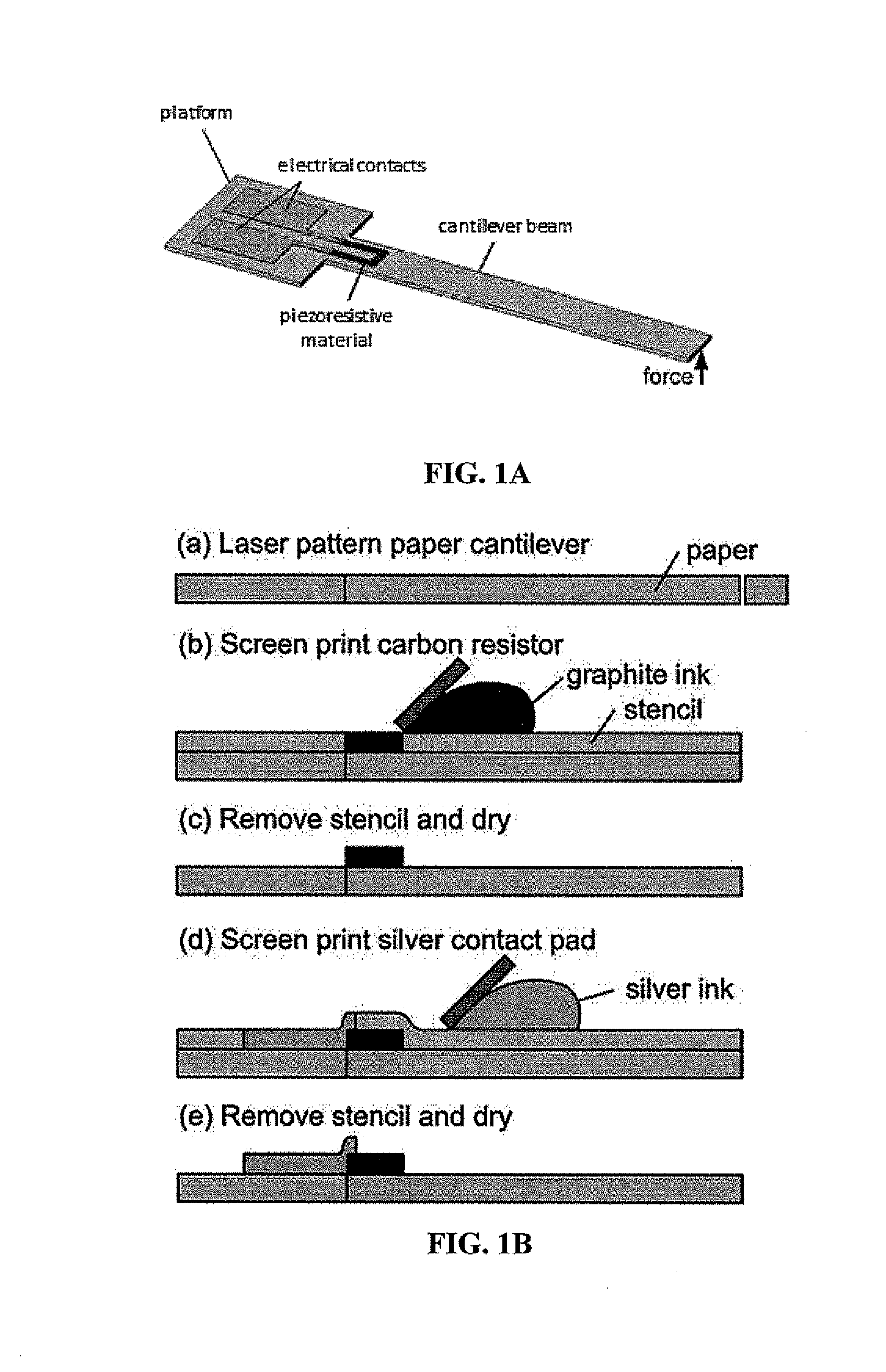MEMS Force Sensors Fabricated Using Paper Substrates
a technology of paper substrates and force sensors, applied in the field of two and three dimensional paper sensors, can solve the problems of limiting the potential use of mems devices in many applications, requiring costly materials, and being conducted in a cleanroom environmen
- Summary
- Abstract
- Description
- Claims
- Application Information
AI Technical Summary
Benefits of technology
Problems solved by technology
Method used
Image
Examples
example 1
Fabrication of a Paper-Based Piezoresistive Force Sensor
[0148]FIG. 1A shows a schematic diagram of a simple, paper-based force-sensing cantilever. In this device, a carbon resistor is located at the root of the cantilever, where the maximum surface strain occurs during detection. The carbon resistor was designed to be short (7 mm) relative to the length (44.5 mm) of the cantilever. When a force is applied to the beam structure, the resistor experiences a mechanical strain / stress, which then induces a change in resistance of the resistor. Measuring the change in resistance allows quantification of the applied force.
[0149]The fabrication of the cantilever beam force sensor is illustrated in FIG. 1B. Whatman® 3MM chromatography paper (catalog number: 3030-6185, 340 μm thick, 186 g / m−2) was selected as a paper substrate for purposes of initial investigation. To render the paper hydrophobic, the surface hydroxyl groups of the paper were functionalized (cellulose fibers) with (tridecafluo...
example 2
Smart Paper Cube: a Three-Axis MEMS Accelerometer
[0179]Paper was used as the structural material for constructing a three-axis MEMS accelerometer. The device measures accelerations based on the principle of piezoresistive effect generated by conductive materials patterned on a paper structure. Three one-axis piezoresistive sensing elements and their readout circuits are first laid out on a piece of patterned paper, and the paper is then folded to form a cube (which we call “smart paper cube”). The three sensing elements are configured on the paper substrate in such a fashion that they locate on three orthogonal surfaces of the paper cube after folding.
[0180]FIGS. 8A-C show a paper-based weighing balance. FIG. 8A shows a schematic side view of a paper-based balance where force-sensing beams with carbon resistors are used for tethering a weighing plate, and measuring the force due to gravity of a weight. FIG. 88 shows the paper-based balance where four force sensing beams are involved...
example 3
Paper as a Hydrophobic Surface
[0188]A hydrophobic surface on paper (i.e., cellulose) was created. A hydrophobic surface is formed on paper by silanizing the surface of paper (cellulose) fibers through chemical vapor deposition. By using different types of chemical reactions to introduce fluorinated and non-fluorinated groups, it was demonstrated that the observed hydrophobicity is due to the exposed surface groups and not the capping of hydroxyl groups on the surface. The linkage bonds were exploited to form pH-sensitive hydrophobic paper surfaces.
[0189]Procedure and Result
[0190]Hydrophobic Paper
[0191]To render paper hydrophobic, the hydroxyl groups of the paper cellulose fibers were functionalized with (tridecafluoro-1,1,2,2-tetrahydrooctyl)trichlorosilane vapor to form surface silanol linkages, and thus generated a hydrophobic surface (FIG. 16A). Six types of paper were silanized and measured for their water contact angles (FIG. 16B) using a contact angle goniometer. Among these t...
PUM
 Login to View More
Login to View More Abstract
Description
Claims
Application Information
 Login to View More
Login to View More - R&D
- Intellectual Property
- Life Sciences
- Materials
- Tech Scout
- Unparalleled Data Quality
- Higher Quality Content
- 60% Fewer Hallucinations
Browse by: Latest US Patents, China's latest patents, Technical Efficacy Thesaurus, Application Domain, Technology Topic, Popular Technical Reports.
© 2025 PatSnap. All rights reserved.Legal|Privacy policy|Modern Slavery Act Transparency Statement|Sitemap|About US| Contact US: help@patsnap.com



